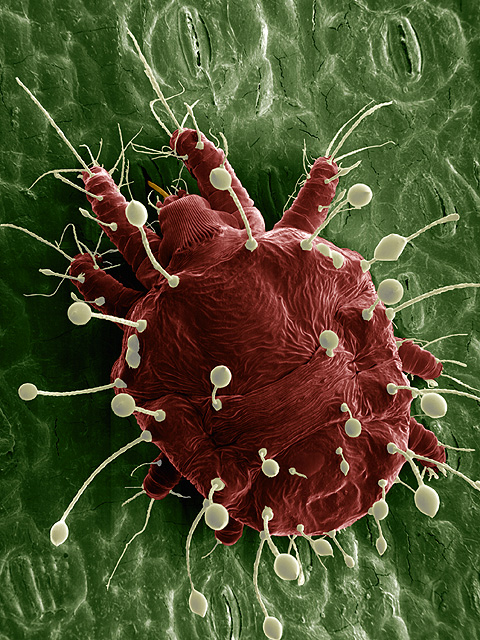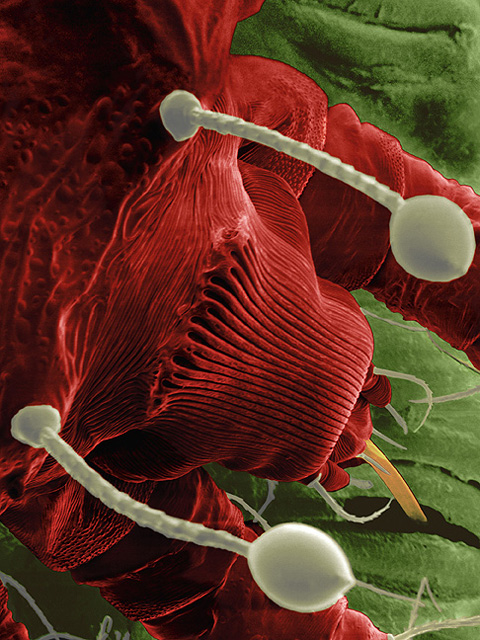 Pictures copied from USDA: A Tiny Menace Island-Hops the Caribbean
Pictures copied from USDA: A Tiny Menace Island-Hops the CaribbeanYet another invasive species is preparing to make landfall in the United States. The red palm mite, Raoiella indica, which can move through wind storms from island to island is also being intercepted on the straw hats of American tourists returning from holidays in the Caribbean. In a wonderful confluence of topics, it is the Beltsville Agricultural Research Center that is a leading contributor to our scientific understanding of this pest.
Many times, gardeners shudder at the sound of proposed restrictions on beloved plants and vilify those researching the effects of invasive species. Yet in almost the same breathe, they come to expect the United States Department of Agriculture to hurry up and defend their gardens against invasive insects and diseases. This year, the current budget proposal for USDA BARC recommends a 5.5 million dollar cut More at the end of this posting on BARC proposed budget cuts.

Invasive species issues are currently defined from the point of view of “natural” area preservation, and not from the ornamental horticulturists’ point of view. It is almost a given certainty that naturalists and gardeners will both endeavor to stop the red palm mite and would support each other in “radical” calls to ban straw hats from vacationers returning to American ports.
“For one, it has spread to other exotic and ornamental palms,” says Ochoa. “And on Dominica, it’s attacking banana plants. In Trinidad, it was observed on Heliconia. Overall, we’re talking about a potentially devastating economic impact. [A Tiny Menace Island-Hops the Caribbean]
Interestingly this invasive species is a challenge to definitions, because if it comes on the winds of a hurricane, then we do not have the direct hand of man involved. Of course if you say that global climate change is because of man then indirectly the hurricanes are the fault of us and we do not violate the federal definition.
 So back to BARC and its finding challenges. If we are going to address and understand our brave new world, we will need the basic science of agriculture to help us find our way. We need more science not less.
So back to BARC and its finding challenges. If we are going to address and understand our brave new world, we will need the basic science of agriculture to help us find our way. We need more science not less.
Many times, gardeners shudder at the sound of proposed restrictions on beloved plants and vilify those researching the effects of invasive species. Yet in almost the same breathe, they come to expect the United States Department of Agriculture to hurry up and defend their gardens against invasive insects and diseases. This year, the current budget proposal for USDA BARC recommends a 5.5 million dollar cut More at the end of this posting on BARC proposed budget cuts.

Invasive species issues are currently defined from the point of view of “natural” area preservation, and not from the ornamental horticulturists’ point of view. It is almost a given certainty that naturalists and gardeners will both endeavor to stop the red palm mite and would support each other in “radical” calls to ban straw hats from vacationers returning to American ports.
“For one, it has spread to other exotic and ornamental palms,” says Ochoa. “And on Dominica, it’s attacking banana plants. In Trinidad, it was observed on Heliconia. Overall, we’re talking about a potentially devastating economic impact. [A Tiny Menace Island-Hops the Caribbean]
Interestingly this invasive species is a challenge to definitions, because if it comes on the winds of a hurricane, then we do not have the direct hand of man involved. Of course if you say that global climate change is because of man then indirectly the hurricanes are the fault of us and we do not violate the federal definition.
 So back to BARC and its finding challenges. If we are going to address and understand our brave new world, we will need the basic science of agriculture to help us find our way. We need more science not less.
So back to BARC and its finding challenges. If we are going to address and understand our brave new world, we will need the basic science of agriculture to help us find our way. We need more science not less.Here is a list of current programs which will take hits this year of congress can not be persuaded to add the money back.
Dairy genetics: continue long-term genetic improvement in dairy cattle, increasing milk yield per cow and feed efficiency (milk produced per pound of feed) over many years.
Barley health food benefits: study barley soluble fiber compounds to lower blood cholesterol and improve insulin and blood sugar control.
Biomineral soil amendments for control of nematodes: research using industrial byproducts as environmentally benign soil additives to control crop damaging nematodes.
Foundry Sand byproducts utilization: develop guidelines for agricultural uses of waste sands from the metal-casting industry; waste sands now are dumped in landfills.
Poultry disease (avian coccidiosis): understanding the genetics of the parasite-host relationship in Coccidiosis, a parasitic disease that costs the poultry industry $2-3 billion annually.
Biomedical materials in plants: using plants to grow vaccines and other pharmaceuticals for both animals and humans, at times referred to as “pharming”.
National Germplasm Resources Program: maintain and service national plant germplasm resources collected over many decades by plant exploration around the world—a vital, irreplaceable scientific resource.
Bovine genetics: research functional bovine genomics to identify specific genes for such traits as easier calving, higher milk production, and resistance to mastitis.
Minor-use pesticides (IR-4): study pest control for such crops as fruits and vegetables, which major corporations for economic reasons tend to overlook for the bigger markets of corn, wheat, and soybeans, and cotton—the “big four” of American crops.
National Nutrition Monitoring System: carry out national surveys of food consumption by individuals and maintain the National Nutrient Database—done in collaboration with HHS, these activities support the school lunch program, WIC, Food Stamps, senior nutrition programs, food labeling, dietetic practices, and others.
Coffee and Cocoa: research to develop environmentally friendly ways to control pests and diseases, and support U.S. chocolate candy production—the single largest U.S. user of fluid milk, sugar, peanuts, and almonds.
Johne’s disease: research this contagious bacterial disease of ruminants, affecting most often dairy cattle—milk producers lose over $54 million annually to this disease.
Food safety—listeria, E.coli, and salmonella: these food-borne illness annually costs $3 billion in health-care costs, and annually costs the economy up to $40 billion in lost productivity.
Weed management research: this research, in collaboration with the Rodale Institute and Pennsylvania State University, studies systems for controlling weeds in organic production systems.
This is your time to get political and call your state Senators and Congressmen; tell them to stop cutting basic science which supports our understanding and our life styles. Who thinks in today’s news market place that we need less E. coli research?
Remind me to write about the National Agricultural Library and its budget problems.
No comments:
Post a Comment